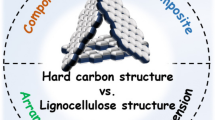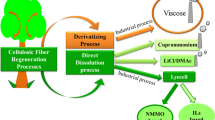Abstract
An Fe3O4-modified lignocellulose (FeLC) composite was fabricated via a sol–gel-assisted hot-pressing process and used for microwave-absorbing and structural materials. The Fe3O4 nanoparticles could be formed in situ at the interface of the lignocellulose (LC) during sol–gel and hot-pressing processing. The obtained FeLC composites exhibited good mechanical and microwave absorption properties. The maximum reflection loss values of the FeLC composite reached − 10.97 dB at 17.04 GHz, and the effective electromagnetic wave absorption reached 90%. Compared with the modulus of rupture (MOR) and modulus of elasticity (MOE) of the LC composite, the maximum MOR and MOE values of the FeLC composite were 26.50 ± 1.16 MPa and 3.015 ± 0.25 GPa, respectively, increasing by 30.2% and 62.1%, respectively. Therefore, the properties of the FeLC could be enhanced via sol–gel assisted hot-pressing.








Similar content being viewed by others
References
Aisyah HA, Paridah MT, Sahri MH, Anwar UMK, Astimar AA (2013) Properties of medium density fibreboard (MDF) from kenaf (Hibiscus cannabinus L.) core as function of refining conditions. Compos Part B-Eng. 44:592–596
Akgül M (2013) Suitability of stinging nettle (Urtica dioica L.) stalks for medium density fiberboards production Compos. Part B Eng 45:925–929
Anglès MN et al (1999) Binderless composites from pretreated residual softwood. J Appl Polym Sci 73:2485–2491
Arevalo-Gallegos A et al (2017) Lignocellulose: a sustainable material to produce value-added products with a zero waste approach—a review. Int J Biol Macromol 99:308–318
Ballner D et al (2016) Lignocellulose nanofiber-reinforced polystyrene produced from composite microspheres obtained in suspension polymerization shows superior mechanical performance. ACS Appl Mater Interfaces 8:13520
Camargo FA, Innocentinimei LH, Lemes AP, Moraes SG, Duran N (2012) Processing and characterization of composites of poly(3-hydroxybutyrate-co-hydroxyvalerate) and lignin from sugar cane bagasse. J Compos Mater 46:417–425
Chen Y, Wang Y, Zhang HB, Li X, Gui CX, Yu ZZ (2015) Enhanced electromagnetic interference shielding efficiency of polystyrene/graphene composites with magnetic Fe3O4 nanoparticles. Carbon 82:67–76
Chen JH, Xu JK, Huang PL, Sun RC (2016) Effect of alkaline pretreatment on the preparation of regenerated lignocellulose fibers from bamboo stem. Cellulose 23:1–13
Chen Y, Dang B, Jin C, Sun Q (2018) Processing lignocellulose-based composites into an ultrastrong structural material. ACS Nano 13(1):371–376
Ciach M, Fröhlich A (2017) Habitat type, food resources, noise and light pollution explain the species composition, abundance and stability of a winter bird assemblage in an urban environment. Urban Ecosyst 20(3):1–13
Dang B, Chen Y, Wang H, Chen B, Jin C, Sun Q (2018a) Preparation of high mechanical performance nano-Fe3O4/wood fiber binderless composite boards for electromagnetic absorption via a facile and green method. Nanomaterials 8:52
Dang B, Chen Y, Yang N, Chen B, Sun Q (2018b) Effect of carbon fiber addition on the electromagnetic shielding properties of carbon fiber/polyacrylamide/wood based fiberboards. Nanotechnology 29(19):195605
Dang B, Chen Y, Yang N, Jin C, Sun Q (2018c) Effect of aluminosilicate on flame-retardant and mechanical properties of lignocellulose composite. Cellulose 25(7):4167–4177
Ding J et al (2014) Fabrication of Fe3O4@reduced graphene oxide composite via novel colloid electrostatic self-assembly process for removal of contaminants from water. J Mater Chem A 3:832–839
Dong X, Zhuo X, Wei J, Zhang G, Li Y (2017) Wood-based nanocomposite derived by in situ formation of organic-inorganic hybrid polymer within wood via a sol–gel method. ACS Appl Mater Interfaces 9(10):9070–9078
Du X, Gellerstedt G, Li J (2013) Universal fractionation of lignin–carbohydrate complexes (LCCs) from lignocellulosic biomass: an example using spruce wood. Plant J 74:328–338
Fan L, Ma Q, Tian J, Li D, Xi X, Dong X, Yu W, Wang J, Liu G (2017) Novel nanofiber yarns synchronously endued with tri-functional performance of superparamagnetism, electrical conductivity and enhanced fluorescence prepared by conjugate electrospinning. RSC Adv. 7(77):48702–48711
Fang C, Diehl BG, Hill JL, Brown NR, Ming T (2013) Covalent bond formation between amino acids and lignin: cross-coupling between proteins and lignin. Phytochemistry 96:449–456
French AD (2014) Idealized powder diffraction patterns for cellulose polymorphs. Cellulose 21(2):885–896
Gaspar D et al (2014) Nanocrystalline cellulose applied simultaneously as the gate dielectric and the substrate in flexible field effect transistors. Nanotechnology 25:094008
Gracheva IE et al (2013) Investigations of nanocomposite magnetic materials based on the oxides of iron, nickel, cobalt and silicon dioxide. J Phys Chem Solid 74(5):656–663
Hao JN, Yan B (2016) A dual-emitting 4d-4f nanocrystalline metal-organic framework as a self-calibrating luminescent sensor for indoor formaldehyde pollution. Nanoscale 8(23):12047–12053
Hasantabar V, Lakouraj M, Zare EN, Mohseni M (2015) Synthesis, Characterization, and biological properties of novel bioactive poly(xanthoneamide-triazole-ethersulfone) and its multifunctional nanocomposite with polyaniline. Adv Polym Technol 36(3):309–319
Hung K-C, Wu J-H (2017) Characteristics and thermal decomposition kinetics of wood-SiO2 composites derived by the sol–gel process. Holzforschung 71(3):233–240
Hung KC, Wu JH (2018) Comparison of physical and thermal properties of various wood-inorganic composites (WICs) derived by the sol–gel process. Holzforschung 72(5):379–386
Jin C, Yao Q, Li J, Fan B, Sun Q (2015) Fabrication, superhydrophobicity, and microwave absorbing properties of the magnetic γ-Fe2O3/bamboo composites. Mater. Design 85:205–210
Jin X et al (2017) Determination of hemicellulose, cellulose and lignin content using visible and near infrared spectroscopy in Miscanthus sinensis. Bioresource Technol. 241:603
Khan AS et al (2018) Dicationic ionic liquids as sustainable approach for direct conversion of cellulose to levulinic acid. J Clean Prod 170:591–600
Khoo HH, Ee WL, Isoni V (2016) Bio-chemicals from lignocellulose feedstock: sustainability, LCA and the green conundrum. Green Chem 18:1912–1922
Kiziltas A, Nazari B, Kiziltas EE, Gardner DJS, Han Y, Rushing TS (2016) Cellulose nanofiber-polyethylene nanocomposites modified by polyvinyl alcohol. J Appl Polym Sci 133(6):42933
Kocaman S, Karaman M, Gursoy M, Ahmetli G (2017) Chemical and plasma surface modification of lignocellulose coconut waste for the preparation of advanced biobased composite materials. Carbohyd Polym 159:48–57
Kostic S, Merk V, Berg JK, Hass P, Burgert I, Cabane E (2018) Timber-mortar composites: the effect of sol-gel surface modification on the wood-adhesive interface. Compos Struct 201:828–833
Lee H et al (2016) Friction and conductance imaging of sp(2)- and sp(3)-hybridized subdomains on single-layer graphene oxide. Nanoscale 8:4063
Lindner B, Petridis L, Schulz R, Smith JC (2013) Solvent-driven preferential association of lignin with regions of crystalline cellulose in molecular dynamics simulation. Biomacromol 14:3390–3398
Liu R, Peng Y, Cao J, Chen Y (2014) Comparison on properties of lignocellulosic flour/polymer composites by using wood, cellulose, and lignin flours as fillers. Compos Sci Technol 103:1–7
Lu Y, Feng M, Zhan H (2014) Preparation of SiO2–wood composites by an ultrasonic-assisted sol–gel technique. Cellulose 21(6):4393–4403
Malara F, Fabbri F, Marelli M, Naldoni A (2016) Controlling the surface energetics and kinetics of hematite photoanodes through few atomic layers of NiOx. ACS Catal 6(6):3619–3628
Mashkour M, Ranjbar Y (2018) Superparamagnetic Fe3O4@wood flour/polypropylene nanocomposites: physical and mechanical properties. Ind Crop Prod 111:47–54
Misek J, Belyaev I, Jakusova V, Tonhajzerova I, Barabas J, Jakus J (2018) Heart rate variability affected by radiofrequency electromagnetic field in adolescent students. Bioelectromagnetics 39(4):277–288
Nayeri DM et al (2014) Medium density fibreboard made from kenaf (Hibiscus cannabinus L.) stem: effect of thermo-mechanical refining and resin content. BioResources 9:2372–2381
Otto GP, Moisés MP, Carvalho G, Rinaldi AW, Garcia JC, Radovanovic E, Fávaro SL (2017) Mechanical properties of a polyurethane hybrid composite with natural lignocellulosic fibers. Compos Part B Eng 110:459–465
Peng X, Zhong L, Ren J, Sun R (2010) Laccase and alkali treatments of cellulose fibre: surface lignin and its influences on fibre surface properties and interfacial behaviour of sisal fibre/phenolic resin composites. Compos Part A Appl Sci Manuf 41(12):1848–1856
Ren J, Dai Q, Zhong H, Liu X, Meng L, Wang X, Xin F (2018) Quaternized xylan/cellulose nanocrystal reinforced magnetic hydrogels with high strength. Cellulose 25(8):4537–4549
Robles E, Czubak E, Kowaluk G, Labidi J (2016) Lignocellulosic-based multilayer self-bonded composites with modified cellulose nanoparticles. Compos Part B Eng 106:300–307
Rowell RM, Mcsweeny JD (2008) Heat treatments of wood fibers for self-bonding and stabilized fiberboards. Mol Cryst Liq Cryst 483(1):307–325
Sheng C, Wang C, Wang H, Jin C, Sun Q, Li S (2017) Self-photodegradation of formaldehyde under visible-light by solid wood modified via nanostructured Fe-doped WO3 accompanied with superior dimensional stability. J Hazard Mater 328:127–139
Sudhakara P et al (2013) Fabrication of Borassus fruit lignocellulose fiber/PP composites and comparison with jute, sisal and coir fibers. Carbohyd Polym 98:1002–1010
Sun X, He J, Li G, Tang J, Wang T, Guo Y, Xue H (2012) Laminated magnetic graphene with enhanced electromagnetic wave absorption properties. J Mater Chem C 1:765–777
Tajik E, Naeimi A, Amiri A (2017) Fabrication of iron oxide nanoparticles, and green catalytic application of an immobilized novel iron Schiff on wood cellulose. Cellulose 25:1–9
Veluchamy C, Kalamdhad AS (2017) Enhancement of hydrolysis of lignocellulose waste pulp and paper mill sludge through different heating processes on thermal pretreatment. J Clean Prod 168:219–226
Wang C et al (2011) The electromagnetic property of chemically reduced graphene oxide and its application as microwave absorbing material. Appl Phys Lett 98(7):217
Wang G, Gao Z, Wan G, Lin S, Yang P, Qin Y (2014) High densities of magnetic nanoparticles supported on graphene fabricated by atomic layer deposition and their use as efficient synergistic microwave absorbers. Nano Res. 7:704–716
Wang C, Xiong Y, Fan B, Yao Q, Wang H, Jin C, Sun Q (2015a) Cellulose as an adhesion agent for the synthesis of lignin aerogel with strong mechanical performance, sound-absorption and thermal Insulation. Sci Rep 6:32383
Wang G, Peng X, Yu L, Wan G, Lin S, Qin Y (2015b) Enhanced microwave absorption of ZnO coated with Ni nanoparticles produced by atomic layer deposition. J Mater Chem A 3(6):2734–2740
Wang H et al (2017) Solvothermal fabrication and growth behavior study of spherical MnFe2O4 through a bottom-up method on wood substrate with effective microwave absorption. RSC Adv 7(40):24764–24770
Wu LQ et al (2016) Presence of monovalent oxygen anions in oxides demonstrated using X-ray photoelectron spectra. Appl Phys Lett 108:173
Xu J, Sugawara R, Widyorini R, Han G, Kawai S (2004) Manufacture and properties of low-density binderless particleboard from kenaf core. J Wood Sci 50(1):62–67
Xu J et al (2017) Synthesis and enhanced microwave absorption properties: a strongly hydrogenated TiO2 nanomaterial. Nanotechnology 28(42):425701
Yuan B, Zhang JM, Mi Q, Yu J, Song R, Zhang J (2017) Transparent Cellulose-silica composite aerogels with excellent flame retardancy via in situ sol–gel process. Acs Sustain Chem Eng 5:11117–11123
Zhang B, Wang J, Wang J, Huo S, Zhang B, Tang Y (2016) Microwave absorption properties of lightweight absorber based on Fe50Ni50-coated poly(acrylonitrile) microspheres and reduced graphene oxide composites. J Magn Magn Mater 413:81–88
Zhao X et al (2017) Characterization of hemicelluloses from Neolamarckia cadamba (Rubiaceae) during xylogenesis. Carbohyd Polym 156:333–339
Acknowledgment
This research was supported by Special Fund for Forest Scientific Research in the Public Welfare (Grant No. 201504501) and Scientific Research Foundation of Zhejiang A&F University [Grant No. 2014FR077].
Author information
Authors and Affiliations
Corresponding authors
Ethics declarations
Conflict of interest
All authors declare that they have no conflict of interest.
Additional information
Publisher's Note
Springer Nature remains neutral with regard to jurisdictional claims in published maps and institutional affiliations.
Rights and permissions
About this article
Cite this article
Dang, B., Chen, Y., Shen, X. et al. Fabrication of Fe3O4-modified lignocellulose composite for microwave absorption via a sol–gel-assisted hot-pressing process. Cellulose 26, 5455–5466 (2019). https://doi.org/10.1007/s10570-019-02499-6
Received:
Accepted:
Published:
Issue Date:
DOI: https://doi.org/10.1007/s10570-019-02499-6




